New perk! Get after it with local recommendations just for you. Discover nearby events, routes out your door, and hidden gems when you sign up for the Local Running Drop.
Squish is king! All hail the squish! While our friends over at Podium Runner are loving shoes with a minimal/responsive feel that connects you with the ground (and the stuff on it), triathletes—me included—have been loving the latest trend of high thickness, maximalist shoes with a big compression and strong energy return. With the days of barefoot running sandals (thankfully) long behind us, major brands have been borrowing from maximalist pioneers like Hoka for basically all of the ‘10s—to varying degrees of success. With the introduction of carbon plates plus squishy foam by Nike a few years back, brands have also followed suit by making sure their squish has some launch as well. The last few years, we’ve also seen a hunt for the perfect combination of impact resistance and softness with some structure for those with less-than-perfect running form. While squishy shoes are great for many, they can also cause peoples’ mechanics to run wild when not reigned in. Hoka did a good job of it with the Arahi 4, Nike did a very ok job of it with the React Infinity Run. (In fact, we put those two in a head to head duel.) New Balance might have topped this year’s pile with their FuelCell Prism, available in August.
Related:
– Face-Off: Asics vs. Saucony Carbon-Plated Showdown (This article is an Active Pass membership exclusive.)
– Reviewed: Hoka’s Fluffy Clifton Edge
– Ask a Gear Guru: What Are This Season’s Lightweight Running Shoes?
New Balance FuelCell Prism: Foam Party
This is one of those shoes that is deceptively simple, but does the basics right. The midsole is (almost) entirely made up of New Balance’s super cushy version of their FuelCell foam. It provides an excellent amount of cushioning upon footstrike—in fact one of the most noticeably squishy rides of any of the “maximalist” shoes we’ve tried this year.
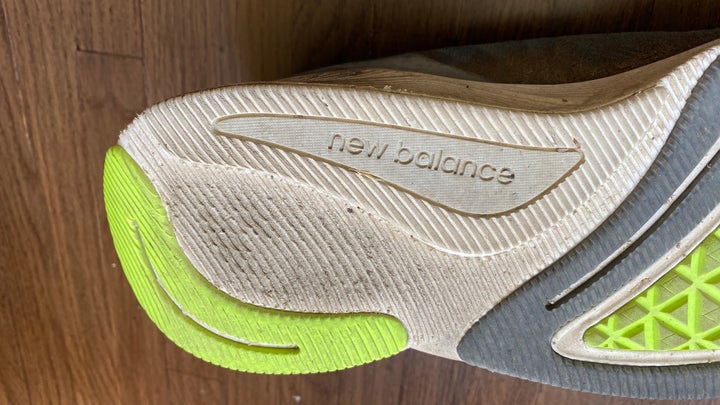
The section of the midsole under your arch may look like the same white FuelCell material, but it’s actually medial support in disguise. With some very hidden seams, the bouncy FuelCell transitions to an incredibly dense material that does an excellent job of providing structure for each footstep. Other brands probably would have painted this neon pink with a neat marketing term and some shiny graphics and textures, but New Balance being New Balance, they’ve almost hidden the support for some reason. However, if you press down on the foam in the midsole, you’ll notice immediately.
New Balance FuelCell Prism: Details Man, Details
Elsewhere on this shoe, New Balance continues to do notable things without anyone really noticing.
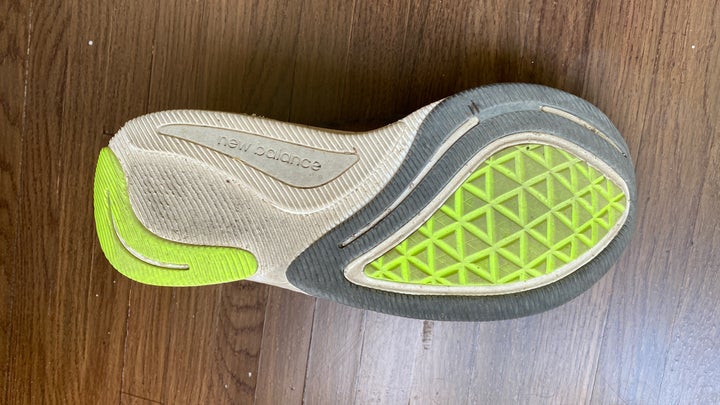
Shockingly, the outsole rubber on the lateral heel and the forefoot do a fantastic job (so far) on protecting the super squishy midsole, where we’ve seen some serious issues with other squishy shoes’ durability this year (the Hoka Clifton Edge, for example). Of course time will tell, but I’ve shredded shoes in far less time than I’ve put into this pair so far, and they’re showing no signs of “troubling” wear.
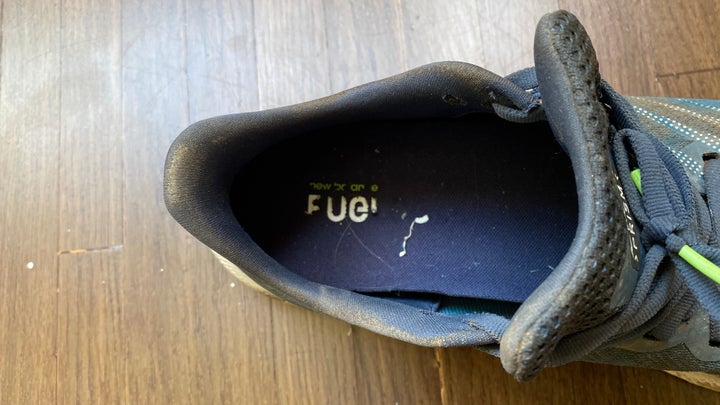
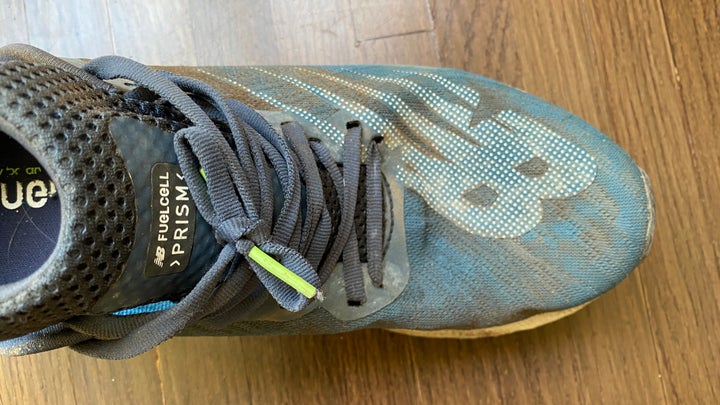
The foot opening is also just about perfect, with an amazingly soft seamless material that wraps the whole heel—material that’s so soft that it works great for the sockless-ly inclined. The upper is a very breathable 3D-woven mesh that continues the seamless/threadless theme throughout to help eliminate any hotspots.
New Balance FuelCell Prism: Light, Right? Still, A Guided Ride
Though weight figures were not entirely consistent as of this writing, other outlets reported around 8.1 ounces for a sample size 9—which is actually quite amazing. Given the super bouncy, moderately structured (particularly when compared to the Nike React Infinity Run), and durable construction of this shoe, I would have assumed this pair tipped the scales much closer to 10 ounces. Even the low price indicates a shoe with less features and refined ride. And yet, this shoe felt noticeably bouncy, particularly when running downhill or on flats, but without the running-on-a-mattress wildness that some of the bouncier kicks can often create.
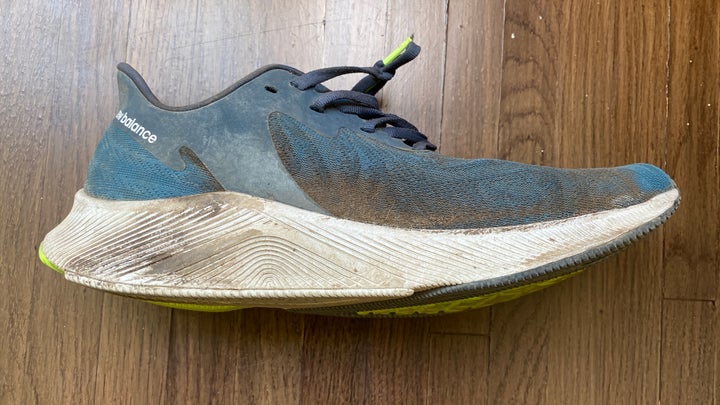
My legs felt adequately supported (though, to be fair my stride is fairly efficient and requires not a ton of support), but still had that cushy effect that so many runners are searching for right now.
New Balance FuelCell Prism: Issues…Notsomuch
The most frustrating thing about wearing these shoes as a reviewer was finding something wrong with them. The traction on the bottom was actually quite good, even when running offroad, and I still can’t get over how protected this soft foam is from the pavement below. That said, I wouldn’t be surprised if the soft FuelCell material might wear out faster due to compression than the outsole would indicate—which can actually be a problem for those who rely on outsole wear to let them know when it’s time to get a new pair. My guess is that you’d want to carefully track your mileage on these shoes so you get a new pair before the foam material is compacted and rendered not helpful. But that’s even kind of a silly complaint. The foot opening seems to be tailor made for triathletes looking to use these as a supportive race day shoe, except that there’s no pull tab on the heel, and I found the heel to still be too short to use as a way to get the shoe on quickly—unlike a few other high-heeled shoes (which have their own issues, by the way).
New Balance FuelCell Prism: Conclusions and Confessions of A Superficial Runner
If you haven’t noticed, I liked these shoes a lot. I was not super excited to try them out, because, well, maybe I’m a shallow and vapid consumer of sports gear, but they just didn’t look that cool to me. There was no carbon plated something something; there were no easily identifiable gimmicks in the midsole for my eye to land on; there wasn’t a giant freaking heel that your running partner could rest on while you run along (social distancing notwithstanding). But this year so far has been the year of being impressed by shoes that maybe don’t set out to impress—take one of my favorites of 2020, the Under Armour HOVR Machina for instance.
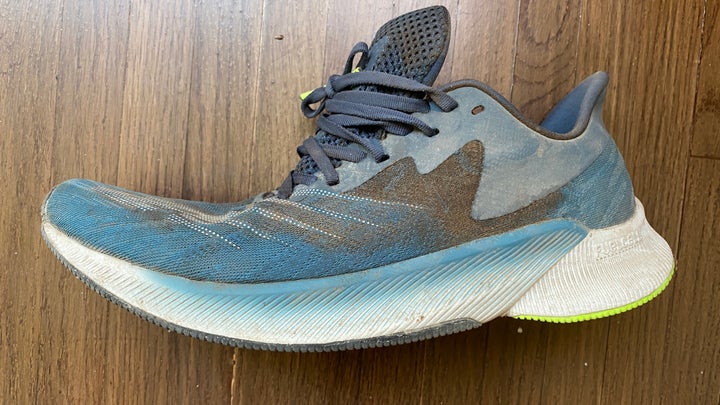
The FuelCell Prisms may look like staid workhorses in the box, but you’ll really feel that noticeable bounce from the first ten strides out the door, and the lack of wild details is actually a worthwhile detail in and of itself. Best yet, they’ll last long enough to put in some serious miles, and when it’s time to replace them, you won’t be staring at a $150 investment. Though New Balance has never been the most exciting brand, they know running shoes very very well, and they certainly know supportive running shoes better than almost anyone else. With the FuelCell Prism they’ve made a shoe that feels exciting even if it doesn’t look the part, while also ensuring that you don’t get swept away in a wobbly marshmallow of the ride.
